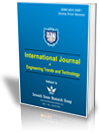Ergonomic Risk Analysis of Workers in Construction Project: A Case Study of Concrete and Brick Wall Work
Ergonomic Risk Analysis of Workers in Construction Project: A Case Study of Concrete and Brick Wall Work |
||
 |
 |
|
| © 2025 by IJETT Journal | ||
| Volume-73 Issue-3 |
||
| Year of Publication : 2025 | ||
| Author : Rosmariani Arifuddin, Rusdi Usman Latief, Yuliafifah Thahirah, Muh Rifan Fadlillah |
||
| DOI : 10.14445/22315381/IJETT-V73I3P101 | ||
How to Cite?
Rosmariani Arifuddin, Rusdi Usman Latief, Yuliafifah Thahirah, Muh Rifan Fadlillah, "Ergonomic Risk Analysis of Workers in Construction Project: A Case Study of Concrete and Brick Wall Work," International Journal of Engineering Trends and Technology, vol. 73, no. 3, pp. 1-12, 2025. Crossref, https://doi.org/10.14445/22315381/IJETT-V73I3P101
Abstract
Construction projects are still prone to accidents. The risk of worker ergonomics is a significant factor driving construction project accident rates. The awkward postures carried out by these workers can impact the emergence of occupational diseases, including Musculoskeletal Disorders (MSDs). The characteristics of construction projects are physical, which causes fatigue to be the main cause of accidents. Concrete work and brick wall work is a very physical work that causes high fatigue. Based on this, it is very important to study ergonomic risk factors in depth at work in construction projects as part of recognizing preventive measures to overcome accidents in construction projects. The research method is a questionnaire survey of 32 respondents in a construction project and direct observation in the field. The ergonomic risk level assessment method uses the Rapid Entire Body Assessment (REBA) method. The findings show that the highest level of MSD complaints in concrete work and wall installation is Back Pain at 90.63%, then Right Upper Arm Pain at 84.38%. Meanwhile, the lowest level of MSD complaints was Left Foot Pain at 21.88%. Based on the ergonomic risk analysis using the REBA method, it is known that the highest ergonomic risk level in concrete work and brick wall work is the High Ergonomic Risk level of 46.88%, then the Moderate Ergonomic Risk level is 37.50%, and the Very High-Risk level is 15.63 %. Based on the chi-squared test, behavior shows a significant relationship between MSD claims and ergonomic risks faced by workers and value (p=0.001).
Keywords
Construction project, MSD, Ergonomic, REBA, Risk management.
References
[1] Mohamad Abdul Nabi, and Islam H. El-Adaway, “Understanding Disputes in Modular Construction Projects: Key Common Causes and Their Associations,” Journal of Construction Engineering and Management, vol. 148, no. 1, 2022.
[CrossRef] [Google Scholar] [Publisher Link]
[2] Carlos M. Zuluaga, Alex Albert, and Munir A. Winkel, “Improving Safety, Efficiency, and Productivity: Evaluation of Fall Protection Systems for Bridge Work Using Wearable Technology and Utility Analysis,” Journal of Construction Engineering and Management, vol. 146, no. 2, 2020.
[CrossRef] [Google Scholar] [Publisher Link]
[3] Sarah Phoya, “Health and Safety Risk Management in Building Construction Sites in Tanzania: The Practice of Risk Assessment, Communication and Control,” Thesis, Chalmers University of Technology, pp. 1-155, 2012.
[Google Scholar] [Publisher Link]
[4] Opeyemi Samuel Williams, Razali Adul Hamid, and Mohd Saidin Misnan, “Accident Causal Factors on the Building Construction Sites: A Review,” International Journal of Built Environment and Sustainability, vol. 5, no. 1, pp. 78-92, 2018.
[CrossRef] [Google Scholar] [Publisher Link]
[5] Gourab Biswas, Arkajit Bhattacharya, and Rina Bhattacharya, “Occupational Health Status of Construction Workers: A Review,” International Journal of Medical Science and Public Health, vol. 6, no. 4, pp. 669-674, 2017.
[CrossRef] [Google Scholar] [Publisher Link]
[6] Ute Latza, Annette Pfahlberg, and Olaf Gefeller, “Impact of Repetitive Manual Materials Handling and Psychosocial Work Factors on the Future Prevalence of Chronic Low-Back Pain Among Construction Workers,” Scandinavian Journal of Work, Environment and Health, vol. 28, no. 5, pp. 314-323, 2002.
[Google Scholar] [Publisher Link]
[7] Andrew Shaun, Health and Safety Accidents and the Causes Analysis within the Construction Industry, Aberdeen University Press Services, 2007.
[Google Scholar] [Publisher Link]
[8] Aulia Tjahayuningtyas, “Factors Affecting Musculoskeletal Disorders (MSDS) Complaints in Informal Workers,” The Indonesian Journal of Occupational Safety and Health, vol. 8, no. 1, pp. 1-10, 2019.
[CrossRef] [Google Scholar] [Publisher Link]
[9] Rakhi Vijayakumar, and Jae-ho Choi, “Emerging Trends of Ergonomic Risk Assessment in Construction Safety Management: A Scientometric Visualization Analysis,” International Journal of Environmental Research and Public Health, vol. 19, no. 23, pp. 1-16, 2022.
[CrossRef] [Google Scholar] [Publisher Link]
[10] Ndukeabasi Inyang et al., “Ergonomic Analysis and the Need for Its Integration for Planning and Assessing Construction Tasks,” Journal of Construction Engineering and Management, vol. 138, no. 12, pp. 1370-1376, 2012.
[CrossRef] [Google Scholar] [Publisher Link]
[11] Tjokorda Bagus Putra Marhaendra et al., “Strategy to Applied Ergonomics on MSMEs during Pandemic Covid-19,” Journal of Social Science Research and Review, vol. 5, no. 11, pp. 1-13, 2022.
[CrossRef] [Google Scholar] [Publisher Link]
[12] Xinming Li et al., “3D Visualization-Based Ergonomic Risk Assessment and Work Modification Framework and its Validation for a Lifting Task,” Journal of Construction Engineering and Management, vol. 144, no. 1, 2018.
[CrossRef] [Google Scholar] [Publisher Link]
[13] Edi Samiranto, ErnaIndriastiningsih, and Kohar Sulistyadi, “Understanding the Concept of Macroergonomics in Efforts to Prevent Workplace Accidents in the Construction Field: A Descriptive Analysis of the Macro, Meso and Micro Thinking Model Approach,” Echo of Informatics, vol. 8, no. 3, pp. 186-198, 2015.
[Google Scholar] [Publisher Link]
[14] Rafael Sacks et al., “Construction with Digital Twin Information Systems,” Data-Centric Engineering, vol. 1, pp. 1-26, 2020.
[CrossRef] [Google Scholar] [Publisher Link]
[15] K.A. Karthick Raja, and K. Murali, “Resource Management in Construction Project,” International Journal of Scientific and Research Publications, vol. 10, no. 5, pp. 252-259, 2020.
[CrossRef] [Publisher Link]
[16] Felipe Muñoz-La Rivera, Javier Mora-Serrano, and Eugenio Oñate, “Factors Influencing Safety on Construction Projects (fSCPs): Types and Categories,” International Journal of Environmental Research and Public Health, vol. 18, no. 20, pp. 1-30, 2021.
[CrossRef] [Google Scholar] [Publisher Link]
[17] Wei Tong Chen et al., “Construction Safety Success Factors: A Taiwanese Case Study,” Sustainability, vol. 12, no. 16, pp. 1-19, 2022.
[CrossRef] [Google Scholar] [Publisher Link]
[18] Emmanuel Eze, Onyinye Sofolahan, and Lawrence Siunoje, “Health and Safety Management on Construction Projects: The View of Construction Tradespeople,” CSID Journal of Infrastructure Development, vol. 3, no. 2, pp. 152-172, 2020.
[CrossRef] [Google Scholar] [Publisher Link]
[19] Law No. 1 of 1970 on Occupational Safety, International Labour Organization, NATLEX. [Online]. Available: https://natlex.ilo.org/dyn/natlex2/r/natlex/fe/details?p3_isn=5257
[20] Z. Mufrida Meri, and Fandi Ahmad, “Measuring the Mental Workload of Employees on the Semi-Finished Rubber Production Floor Using the Nasa TLX (Taskload Index) Method,” UNISI Journal of Industrial Tennis, vol. 4, no. 1, pp. 19-25, 2020.
[CrossRef] [Google Scholar] [Publisher Link]
[21] Di Wang, X. Ning, and Fei Dai, “Risk Assessment of Work-Related Musculoskeletal Disorders in Construction: State-of-the-Art Review,” Journal of Construction Engineering and Management, vol. 141, no. 6, 2015.
[CrossRef] [Google Scholar] [Publisher Link]
[22] Rovanaya Nurhayuning Jalajuwita, and Indriati Paskarini, “The Relation Between Body Position with Musculoskeletal Complaints in Welding Unit of PT. X Bekasi,” The Indonesian Journal of Occupational Safety and Health, vol. 4, no. 1, pp. 33-42, 2015.
[CrossRef] [Google Scholar] [Publisher Link]
[23] Jeffrey E. Fernandez, “Ergonomics in the Workplace,” Facilities, vol. 13, no. 4, pp. 20-27, 1995.
[CrossRef] [Google Scholar] [Publisher Link]
[24] Nooraidawati Jaffar et al., “A Literature Review of Ergonomics Risk Factors in Construction Industry,” Procedia Engineering, vol. 20, pp. 89-97, 2011.
[CrossRef] [Google Scholar] [Publisher Link]
[25] P. Tarwaka, and L.S. Bakri, Industrial Ergonomics Basics of Ergonomics Knowledge and Application in the Workplace, Badan Penerbit Harapan Press: Surakarta, 2015.
[Google Scholar]
[26] Nana Rahdiana, “Identification of Ergonomic Risks of Guillotine Cutting Machine Operators using the Nordic Body Map Method (Case Study at PT. XZY),” IndustryXplore, vol. 2, no. 1, pp. 1-12, 2017.
[CrossRef] [Publisher Link]
[27] Silvi Ariyanti, and Kiki Arifin, “Redesigning Extrusion Torque For Glass Panel Installation With Ergonomic Approach,” Scientific Journal of Industrial Engineering, vol. 7, no. 1, pp. 8-15, 2019.
[Google Scholar]
[28] Andreas Monnier et al., “Musculoskeletal Pain and Limitations in Work Ability in Swedish Marines: A Cross-Sectional Survey of Prevalence and Associated Factors,” BMJ Open, vol. 5, no. 10, pp. 1-10, 2015.
[CrossRef] [Google Scholar] [Publisher Link]
[29] Manuel Hita-Gutiérrez et al., “An Overview of REBA Method Applications in the World,” International Journal of Environmental Research and Public Health, vol. 17, no. 8, pp. 1-22, 2020.
[CrossRef] [Google Scholar] [Publisher Link]
[30] Sue Hignett, and Lynn McAtamney, “Rapid Entire Body Assessment (REBA),” Applied Ergonomics, vol. 31, no. 2, pp. 201-205, 2000.
[CrossRef] [Google Scholar] [Publisher Link]
[31] Mark Middlesworth, A Step by Step Guide Rapid Entire Body Assessment (REBA), Ergonomics Plus, pp. 1-11. Online. [Available]: https://ergo-plus.com/wp-content/uploads/REBA-A-Step-by-Step-Guide.pdf

